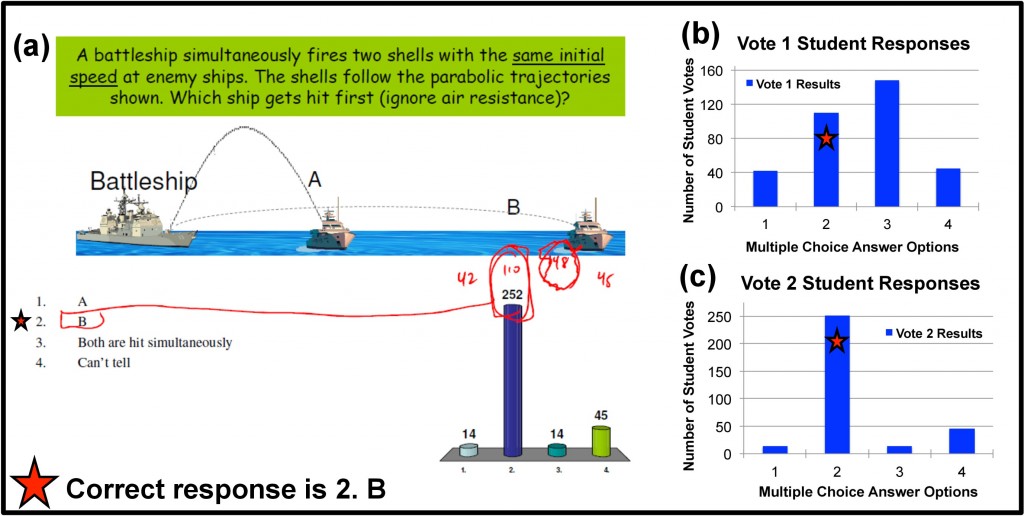Peer Instruction & Think-pair-share
"Through PI, students realize that trying to articulate their position with other students, and having those students disagree and articulate their reasoning back to them, can be a powerful learning experience."

What is it?
Peer instruction is an instructional strategy that encourages students to verbalize their answer and selection rationale, actively listen to their peer’s rationale, and critically compare / contrast their explanations with those of others. Students are presented with multiple-choice questions testing their conceptual understanding. They select an answer and communicate their choice (i.e., vote). This can involve any of the following tools: response device (often referred to as clickers), flash cards, or discreet hand signals. The tabulated responses enable the instructor to determine the next pedagogical move in real-time (i.e., in accordance to student understanding). If a significant proportion of students select an incorrect response, they are given the opportunity to debate/discuss their answers with a peer(s) before re-voting. Following the second vote, the instructor presents the correct response and makes any necessary clarifications.
Essential features for successful implementation of this strategy: (1) Conceptual questions: Selecting multiple-choice questions that tap into students’ understanding of concepts that are often misunderstood initially (i.e., student’s prior knowledge may be erroneous or may not be consistent with the manner in which a particular discipline understands the concept). (2) Peer discussion: Providing time for peer-to-peer discussion. This discussion is most effective when peers with different answers (i.e., views, understanding, etc.) talk and explain to each other.
This strategy supports conceptual learning. Often, students who came to the wrong conclusion in the first vote, are able to answer the question correctly on the second vote through this process of discussion and debate with peers.
Note: Peer Instruction is similar to Think-pair-share. However, though Think-pair-share follows three major steps of peer instruction it tends to be less formal, requiring less preparation by an instructor to implement. With Think-pair-share, students are given a question or problem to solve. The instructor allows them a few minutes to think about the problem alone (think), then has students group together (pair) and discuss to compare and elaborate on their thinking (share). This can be followed up with a whole class share – especially for more complex content. This strategy can be an effective way to break up a lecture by enabling students to engage with course content, discuss with their peers and share knowledge.
Skills Promoted
- Communication
- Conceptual reasoning
- Evaluative reasoning
- Metacognition
Who's using it?
SALTISE community members who use this strategy and are willing to share advice and/or resources.
| Institution | Discipline | Instructor | Classroom settings |
|---|---|---|---|
|
McGill University Level: University |
Engineering |
Traditional Classroom Classroom size: 100 |
|
|
McGill University Level: University |
Engineering - Ethics |
Traditional Classroom Classroom size: 200 |
|
|
University of Guelph Level: University |
Social Sciences |
Traditional Classroom Classroom size: 20-40 |
|
|
McGill University Level: University |
Engineering |
Traditional Classroom Classroom size: 75-95 |
|
|
McGill University Level: University |
Physics |
Lecture hall (auditorium) Classroom size: 450 |
|
|
Marianopolis College Level: College |
Physics |
Classroom with whiteboards Classroom size: 30-40 |
| Institution |
McGill University Level: University |
McGill University Level: University |
University of Guelph Level: University |
McGill University Level: University |
McGill University Level: University |
Marianopolis College Level: College |
|---|---|---|---|---|---|---|
| Discipline |
Engineering |
Engineering - Ethics |
Social Sciences |
Engineering |
Physics |
Physics |
| Instructor | ||||||
| Classroom settings |
Traditional Classroom Classroom size: 100 |
Traditional Classroom Classroom size: 200 |
Traditional Classroom Classroom size: 20-40 |
Traditional Classroom Classroom size: 75-95 |
Lecture hall (auditorium) Classroom size: 450 |
Classroom with whiteboards Classroom size: 30-40 |
Why use it?
Overall, PI allows students to look at the problem in a different light through critical evaluation of peer discussions. When students actively listen to one another during PI, there is always clear motion towards the right answer. Consider the PI example provided in Figure 1a below. While only approximately 32% of students were able to come to the correct answer on their own (Figure 1b), following the PI process, 78% of students (Figure 1c) came to the correct conclusion.

One of the powerful aspects of PI is that students realize that some problems are not as easy as they originally thought. After the students vote on the problem, there is a moment of silence before the results of the vote are presented. Prior to seeing these results, students collectively feel they aced the problem. Nonetheless, the voting often exhibits a three way split between possible answers. Consequently at least two-thirds of the students wind up realizing ‘maybe the problem is not as obvious as I thought’. Students must then ask themselves where they went wrong. The instructor can sense them becoming engaged through discussion. When students vote for the second time, there is dead silence in the room as they are wondering how everyone did and if they are moving towards the right solution. This is what makes PI an effective strategy.
I am increasingly encouraging my students to form PI-based study groups outside the classroom.
As with all strategies, PI only goes so far. An instructor will rarely observe over 80% of students answering a conceptual question correctly, even with the PI process. In Figure 1, we observe that 32 percent of students still struggled with the sample question presented following PI. When student responses are spread, the instructor can sense that some students are going down the wrong path collectively (especially when students have deeply held misconceptions). Furthermore, no amount of instruction among peers will bring them to the correct answer. Thus, following the PI process, the instructor must intervene and guide the discussion in the right direction, allowing students to examine the problem in a different way. This is where a different strategy may be needed.
Ready to try it out?
This version of Peer Instruction (PI) is a six step instructional process. Other iterations of this process are possible depending on the pedagogical needs.
STEP 1: Instructor provides students with content (e.g., mini-lecture, pre-class reading).
STEP 2: Instructor prepares multiple choice questions/problems.
BEST PRACTICES NOTE: Concept-based questions are the most effective to promote student debate and discussion of understanding).
STEP 3: Individually, students answer the question and enter their vote using a polling method or device (e.g., clickers or phone app).
BEST PRACTICES NOTE: maintain anonymity of choice even when polling does not use technology See document for options.
IF less than 35% answer correctly:
STEP 4 : Instructor revisits the concepts required to answer the question.
IF between 35-70% answer correctly:
STEP 5: Students, in pairs or small groups, discuss their answers and explain their reasoning.
BEST PRACTICES NOTE: pairs or groups should consist of individuals holding different opinions, or playing the skeptic and arguing for an alternative answer.
STEP 6: Individually, students vote again and select answer based on discussion – they can either keep their original answer or change.
IF more than 70% answer correctly:
STEP 7: Instructor briefly reviews the concepts.
STEP 8: Instructor begins presenting material relating to the next topic.

Strategy Workflow
Helpful resources
Tech Tools
References
Crouch, C. H. and Mazur, E. (2001). Peer instruction: Ten years of experience and results. American Journal of Physics.
Henderson, C. (2008). Promoting instructional change in new faculty: An evaluation of the Physics and Astronomy new faculty workshop. American Journal of Physics.
Schell, J. A. and Butler, A. C. (2018). Insights From the Science of learning can inform evidence-based implementation of peer instruction. Frontiers in Education.
Flacks, G. (2017). myDALITE, An asynchronous peer instruction platform supporting students and teachers. Vitrine technologie-éducation (VTÉ).
Kelly Miller, Schell, J., Ho, A., Lukoff, B. and Mazur, E. (2015). Response switching and self-efficacy in peer instruction classrooms. Physical Review Special Topics - Physics Education Research.
Kelly Miller, Nathaniel Lasry, Lukoff, B., Schell, J. and Mazur, E. (2014). Conceptual question response times in peer instruction classrooms. Physical Review Special Topics - Physics Education Research.
Sameer Bhatnagar, Nathaniel Lasry, Desmarais, M., Michael Dugdale, Chris Whittaker and Elizabeth S. Charles (2015). An analysis of peer-submitted and peer-reviewed answer rationales, in an asynchronous peer instruction based learning environment. International Educational Data Mining Society..
Sameer Bhatnagar, Nathaniel Lasry, Desmarais, M. and Elizabeth S. Charles (2014). Taking DALITE to the next level: What have we learned from a web-based peer instruction application?. Proceedings of the 11th International Conference of the Learning Sciences (ICLS 2014). International Society of the Learning Sciences: Boulder, CO..
Elizabeth S. Charles, Nathaniel Lasry, Sameer Bhatnagar, Rhys Adams, Kevin Lenton, Yann Brouillette, Michael Dugdale, Chris Whittaker and Phoebe Jackson (2019). Harnessing peer instruction in and out of class with myDALITE. Fifteenth Conference on Education and Training in Optics and Photonics (SPIE Digital Library).
Videos
Eric Mazur – Peer Instruction – Dean and Professor of Applied Physics, Harvard University, and Vice-President of the Optical Society
TO LEARN MORE
For more resources go to Articles and Books






